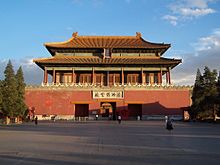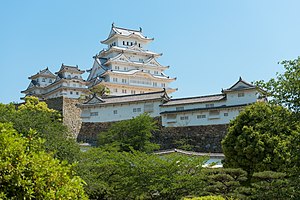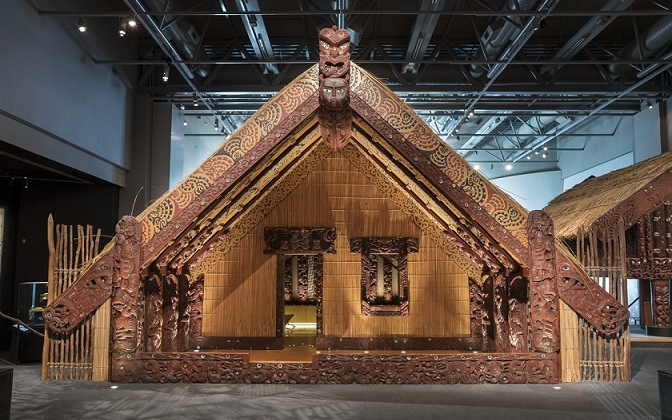The Forbidden City, 25-8 on page 331 or 816
The Forbidden City in Beijing represents the conflicting and deep history of China. Built-in the time period when the Mongols invaded China, the architecture was a part of their city plans. During the Ming dynasty, the Mongols copied the foundations of the ancient Chinese culture as they planned, setting down symmetry and balance which reflects the ancient Chinese beliefs: Daoism, the harmony of the universe. The buildings reflected the old traditions of scholars separating themselves from the common population. However, the scholars were separating themselves from the government as well.

The Forbidden City, Kuai Xiang, 1925
One of China’s many neighbors, Japan, an architecture was created in the most creative era: the Momoyama period. The European weapons were introduced during Japan’s civil wars and brought three significant leaders: Oda Nobunaga, Toyotomi Hideyoshi, and Tokugawa Ieyasu. A new style of architecture sprung up to defend against the new weapons and one of the architectures was the Himeji Castle in Hyogo.
The Himeji Castle, 26-9 on page 334 or 839.
This castle reflects the artistic traditions of asymmetry, sleek lines, abstraction, and boldness while using natural materials. Perched high up into the air, the castle offers a clear view of the landscapes on all sides, which of course was great for spotting enemies, but also reflects the traditional aesthetic Zen landscapes.
Far South of Japan and a tad to the East, there lies Australia. Their arts were recognized as stylistic or geometric, the geometry style frequented in bark cloth, tattoos, and ceramics. Their art were either decors or used for religious practices. Their religion consists of the concept Dreamtime and it refers to the time before humans existed. Basically, the Dreamtime is a Minecraft flatlands world and the Spirits were the players terraforming the landscapes to their hearts’ desires. The Spirits emerged from the lands and oceans and are believed to be found in particular places. On a eucalyptus bark is the artwork of Three Dancers and Two Musicians.
 The Himeji Castle Akamatsu Norimura 1333
The Himeji Castle Akamatsu Norimura 1333
Three Dancers and Two Musicians, 28-3 on page 373 or 878
Like their neighbor in Australia, Polynesia’s arts are emphasized on religion and religion only. Polynesia’s master artists were also ritual specialists and thus Polynesia’s art culture are recognized through carvings on stone, wood, and human bones.. Wooden houses were built and turned into meeting houses and were homages to the ancestors; the dead were believed to be gods.

This castle reflects the artistic traditions of asymmetry, sleek lines, abstraction, and boldness while using natural materials. Perched high up into the air, the castle offers a clear view of the landscapes on all sides, which of course was great for spotting enemies, but also reflects the traditional aesthetic Zen landscapes.
Far South of Japan and a tad to the East, there lies Australia. Their arts were recognized as stylistic or geometric, the geometry style frequented in bark cloth, tattoos, and ceramics. Their art were either decors or used for religious practices. Their religion consists of the concept Dreamtime and it refers to the time before humans existed. Basically, the Dreamtime is a Minecraft flatlands world and the Spirits were the players terraforming the landscapes to their hearts’ desires. The Spirits emerged from the lands and oceans and are believed to be found in particular places. On a eucalyptus bark is the artwork of Three Dancers and Two Musicians.
 The Himeji Castle Akamatsu Norimura 1333
The Himeji Castle Akamatsu Norimura 1333Three Dancers and Two Musicians, 28-3 on page 373 or 878
Like their neighbor in Australia, Polynesia’s arts are emphasized on religion and religion only. Polynesia’s master artists were also ritual specialists and thus Polynesia’s art culture are recognized through carvings on stone, wood, and human bones.. Wooden houses were built and turned into meeting houses and were homages to the ancestors; the dead were believed to be gods.

Te-Hau-Ki-Turanga (Maori Meeting House), 28-11 on page 380 or 885
Te-Hau-Ki-Turanga is the oldest meeting house and it was built by Rukupto, who designed and built the house for his elder brother who had died. The elder brother was considered to be the founder of New Zealand, and the house symbolizes his body and the ancestors supporting the village. The ridge pole were considered to be his backbone, rafters the ribs, the face in a gable mask, and slanting bargeboards the protective arms. The ancestors were the supporting protection for the house, covering the ridge pole, the wall planks, and the ends of the rafters. The elder child were the more sacred child because they were considered to have the most “spirit” in the family, so the death of Rukupto’s brother was devastating. Designing and building the meeting house was a way to show the importance of genealogy.

Te-Hau-Ki-Turanga Raharuhi Rukupō 1840
On the other side of the world, the Americas offers a history of their own. In the Valley of Mexico lies the extinct Aztec Empire, brought to ruins by the Spanish. While the Aztec Empire was thriving and coexisting with the Spains, the King of Spains, Holy Roman Emperor Charles V requested an art book about the Aztecs. The most significant example from the book was The Foundings of Tenochtitlan.
Te-Hau-Ki-Turanga is the oldest meeting house and it was built by Rukupto, who designed and built the house for his elder brother who had died. The elder brother was considered to be the founder of New Zealand, and the house symbolizes his body and the ancestors supporting the village. The ridge pole were considered to be his backbone, rafters the ribs, the face in a gable mask, and slanting bargeboards the protective arms. The ancestors were the supporting protection for the house, covering the ridge pole, the wall planks, and the ends of the rafters. The elder child were the more sacred child because they were considered to have the most “spirit” in the family, so the death of Rukupto’s brother was devastating. Designing and building the meeting house was a way to show the importance of genealogy.

Te-Hau-Ki-Turanga Raharuhi Rukupō 1840
On the other side of the world, the Americas offers a history of their own. In the Valley of Mexico lies the extinct Aztec Empire, brought to ruins by the Spanish. While the Aztec Empire was thriving and coexisting with the Spains, the King of Spains, Holy Roman Emperor Charles V requested an art book about the Aztecs. The most significant example from the book was The Foundings of Tenochtitlan.
The Founding of Tenochtitlan, 27-3 on page 349 or 854.
The artwork here signifies the culture of the Aztecs. The central figure within the x’ed box is a reference to the story of why the founders decided to settle in Central Mexico. Within the said box is the precinct where many buildings are and the temple on the upper triangles. This is significant since it shows that they are civilization and they have monuments important to them. To the right of the eagle and the cactus and the stone is a skeleton, and this represents the sacrifices the civilians made for their gods to keep the world alive. The blue borders represent the landscape and how they expanded their city on the water. Then at the bottom of the Inked art piece is the soldiers of Aztec going out to conquer more lands, defend their lands, and fight for their gods. The two temples near them are the two temples that the sun sets onto depending on the time of year.
:max_bytes(150000):strip_icc()/Codex_Duran-Founding_of_Tenochtitlan-56ffc04a3df78c7d9e57debd.jpg)
The Founding of Tenochtitlan Aztec Empire 1325
Citation Stokstad, Marilyn, and Michael Watt Cothren.Art History.Sixth ed,.II, Pearson,2018.
No comments:
Post a Comment